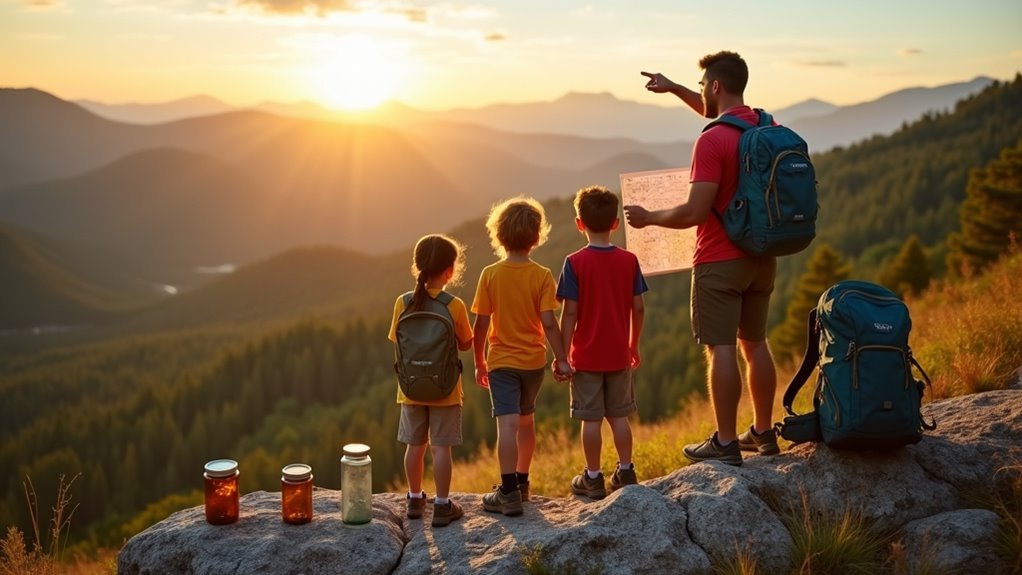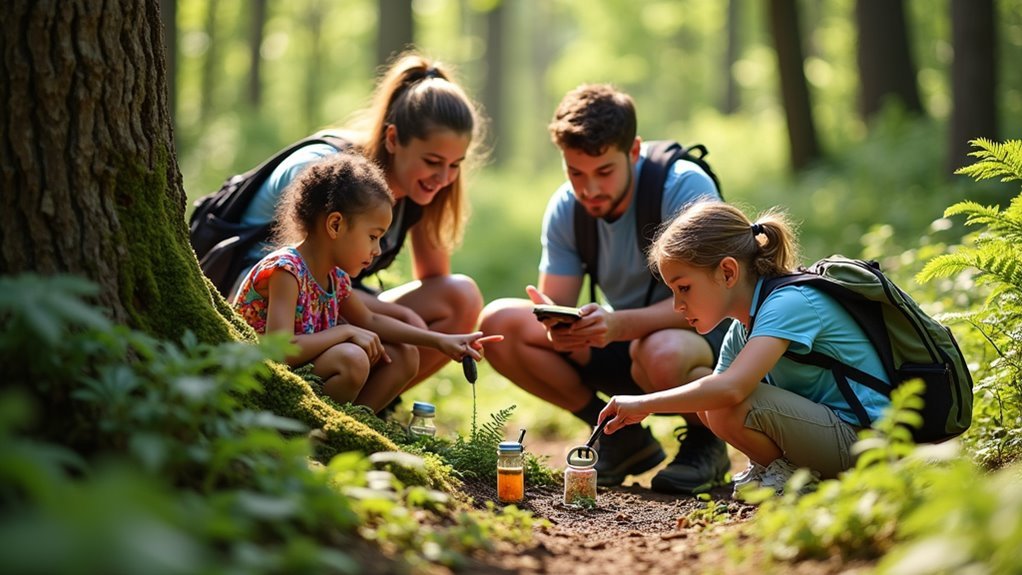Some of the links in this article may be affiliate links. If you make a purchase through these links, we may earn a small commission at no extra cost to you. Thank you.
I’ve found that geocaching with my kids tends to fizzle out after a few outings without clear goals to keep them engaged. The initial excitement wears off, and then what? Setting up progressive challenges has completely transformed our experience—whether it’s badge systems, difficulty ladders, or themed quests. If you’re struggling to maintain your children’s interest in outdoor adventures, these motivation techniques might be exactly what your family needs. Want to know which one worked best for us?
Setting Difficulty Rating Progression Goals

How do you transform geocaching from a simple hobby into an engaging family adventure? I’ve found that setting progressive difficulty goals is the perfect way to keep everyone motivated, especially kids who thrive on achievement.
Start with easy caches rated 1 to 1.5 on the difficulty scale.
The free Geocaching app is perfect for this, as it naturally limits access to these beginner-friendly options.
Once your little explorers have found, say, five easy caches, challenge them to level up to a 2 or 2.5 rating.
I think of it like video game levels – each difficulty rating conquered is an achievement earned!
As your family’s skills improve, you can gradually work toward those tricky level 3 caches that might involve puzzles or more challenging terrain.
Creating Themed Collection Challenges
I’ve found that creating themed geocaching collections like Regional Explorer Series, Seasonal Cache Hunts, and Hidden History Quests can transform ordinary family outings into meaningful adventures.
You can tailor these themes to your kids’ interests—maybe your history buff would love tracking down caches at local historical landmarks, or perhaps your nature-loving child would be thrilled with seasonal wildlife-themed hunts.
These themed challenges aren’t just fun; they’re stealth learning opportunities that’ll have your family bonding while discovering your community in ways you never imagined.
Regional Explorer Series
The Regional Explorer Series adventure path offers families an exciting way to elevate their geocaching experience beyond random cache hunts.
I’ve found that creating a themed collection of up to 20 quests centered around local history or natural landmarks gives kids something concrete to work toward.
Using apps like Geocaching or Globe Chaser, you can design custom explorations of places like Wichita or Phoenix where there are tons of caches already listed.
What I love most is how you can tailor the difficulty levels to match your children’s abilities.
In my experience, nothing beats watching kids collect those virtual badges or trading SWAG items after completing a challenging outdoor activity.
It’s like turning your weekend hikes into treasure hunts with an educational twist!
Seasonal Cache Hunts
Seasonal cache hunts transform ordinary family outings into magical expeditions that keep pace with nature’s changing canvas.
I’ve found the Geocaching app makes it super easy to select themed caches that match whatever season we’re in.
My kids absolutely love the treasure hunt aspect, especially when we set challenges like finding five fall-themed caches with educational elements about local leaves.
- Create winter puzzle caches with holiday-themed clues
- Design summer SWAG exchanges with beach toys or sunglasses
- Track seasonal trackables that “migrate” like birds from spring to fall
- Set up autumn challenges focusing on local foliage identification
- Organize winter-to-spring progression hunts that follow melting snow patterns
These outdoor adventures become more meaningful when they connect to what’s happening in nature around us.
The excitement in my children’s eyes when they discover season-specific treasures? Priceless!
Hidden History Quests
While seasonal geocaching connects us to nature’s rhythm, uncovering our community’s past brings a whole new dimension to family adventures.
I’ve found that creating “Hidden History Quests” turns ordinary treasure hunting into educational journeys that kids actually enjoy!
Using the Geocaching app, I select caches near historical landmarks or create my own themed collection—like Revolutionary War sites or indigenous settlements.
My kids love solving history-based puzzles to find the next cache.
Sometimes I’ll include QR codes linking to fascinating historical facts.
What’s amazing about geocaching with kids is how it transforms outdoor exploration into meaningful learning.
In my experience, children retain information better when there’s a sense of adventure involved.
They’re not just finding containers; they’re discovering stories buried in our landscape!
Designing Family Geocaching Tournaments
I’ve found that assigning points based on cache difficulty creates the perfect competitive balance for family tournaments—maybe start with 5 points for easy finds and work up to 15 for those trickier ones.
As your kids progress, you’ll want to gradually increase the challenge level, perhaps beginning with 1-1.5 difficulty ratings before tackling those 2-2.5 caches that require more problem-solving.
Don’t forget to create special awards for unique finds; in my experience, nothing motivates my own children more than earning the “History Detective” badge for discovering historical markers or the “Nature Explorer” certificate for caches hidden in interesting natural settings.
Points Per Cache Found
Have you ever wondered how to make geocaching truly exciting for the whole family?
I’ve found that creating a points system for each cache found makes this outdoor activity instantly more engaging.
My kids get absolutely thrilled when they earn points based on the difficulty of each find—it’s like turning exploration into a game they can’t get enough of!
Here’s how I structure our points system:
- 1 point for easy-to-find 1-star caches (perfect for beginners)
- Bonus points for larger caches that contain SWAG or tradeable items
- Additional points based on terrain difficulty (challenging hikes earn more!)
- Extra rewards when kids find caches in new environments
- Personalized goals for each child based on their experience level
Cache Difficulty Progression
Three key stages of cache difficulty progression can transform ordinary geocaching into thrilling family tournaments that grow with your children’s skills.
I always recommend starting with 1-star caches using the free app to find these simple treasures – they’re perfect confidence-builders for young geocachers!
Once they’ve mastered the basics, move to 2-3 star caches that might involve a short hike or solving simple clues.
My kids loved this middle stage where their navigation skills really developed.
For older kids who’ve caught the geocaching bug, don’t hesitate to introduce 4-5 star caches that involve puzzles or a long hike over challenging terrain.
I’ve found celebrating milestones at each difficulty level – maybe after finding 5 caches – keeps everyone motivated to progress!
Awards For Unique Finds
Designing creative tournaments adds a completely new dimension to your family’s geocaching adventures.
I’ve found that awarding points for unique finds transforms an ordinary outing into a Modern-Day Treasure hunt that keeps kids engaged for hours!
When my family started tracking special finds, my children’s excitement for geocaching skyrocketed.
Here’s how I structure our family tournaments:
- Award custom badges for discovering history-focused or wildlife caches
- Offer bonus points for finds rated above 2.0 difficulty
- Use special SWAG items as prizes for the most unique treasures
- Create digital certificates when reaching the 5th unique cache milestone
- Implement team challenges where siblings work together to find hidden caches
Trust me, there’s nothing like seeing your child’s face light up when they trade for that special treasure they’ve been hunting!
Establishing Milestone Rewards Systems
Creating a milestone rewards system might be the secret ingredient to keeping kids engaged in family geocaching adventures.
Celebrate each geocaching milestone with rewards, and watch your kids transform into enthusiastic explorers ready for the next adventure.
I’ve found that children love earning rewards after they sign the logbook in every fifth cache, maybe letting them choose a special item from the cache as their prize.
For my family, offering snacks after we find a cache works wonders for motivation!
We also track our discoveries on a rewards chart, promising a new toy after reaching 10 caches.
I think the best approach is making it collaborative—we work together to locate caches, but I let my kids lead the hunt after two successful finds.
This builds their confidence while teaching navigation skills.
It’s almost like turning geocaching into a game within a game, which keeps everyone coming back for more.
Incorporating Nature Exploration Objectives

The natural world offers an incredible backdrop for geocaching adventures, and I’ve found it’s easy to weave environmental education into our treasure hunts.
When you’re spending time outdoors with kids, use each cache as an opportunity to become more aware of your surroundings.
My family always takes a minute after signing the logbook to identify three native plants or animals nearby.
Here are some nature exploration challenges I’ve found effective:
- Have children photograph and identify five local tree species during your hunt
- Create a “poison ivy awareness” game where kids earn points for spotting it safely
- Challenge everyone to collect one piece of litter at each cache location
- Set goals to explore three different ecosystems (forest, wetland, meadow) in one day
- Assign children to record wildlife sightings in their own nature journal
Crafting Seasonal Geocaching Quests
Seasons breathe new life into geocaching adventures, making each quest feel fresh and exciting throughout the year.
When I first started geocaching with my kids, I quickly realized how the Globe Chaser app makes finding activities that match the current season incredibly simple.
In just minutes, I can design quests that incorporate autumn leaf hunts or winter-themed treasure searches.
What I love most is how the app helps my kids know exactly what to expect with its 1-5 star difficulty ratings.
We begin with easier caches during spring, then gradually tackle more challenging ones as they grow confident.
It’s been a fun new tradition to seek out educational caches that highlight seasonal wildlife or local history.
The multilingual support means we can even plan quests when traveling!
Developing Digital Badge Achievement Tracks

Digital badge achievement tracks have completely transformed our family geocaching experience.
As a cache owner myself, I’ve found that apps like Globe Chaser make it easy to create custom achievement systems that keep my kids motivated.
If you’re giving geocaching a try for the first time, these digital badges offer fantastic structure for beginners.
- Create age-appropriate tracks (elementary kids love 1-star difficulty caches!)
- Design badges for milestones (like signing 10 logbooks)
- Incorporate local history challenges for educational value
- Set up seasonal quests with special limited-time badges
- Award special achievements for trying different GPS devices
I think the Beginners Guide should definitely mention these digital tracks—they’ve turned our occasional weekend activity into a passionate family hobby.
My 13-year-old now reminds me when it’s time to go caching, not the other way around!
Building Multi-Cache Adventure Missions
Have you ever considered turning a regular geocaching outing into an epic family adventure?
I’ve found that multi-cache missions are perfect for keeping kids engaged while exploring.
Start by selecting 3-5 beginner-friendly caches (1-2 star difficulty) within a mile total distance, which is ideal for younger explorers.
When planning your route, look for caches that often contain small tradeable items – kids love finding these!
Remember that GPS accuracy is typically within 30 feet, so prepare your little ones for some searching.
The size of the cache usually increases along the journey, which builds excitement.
I always remind my children: if you take something, leave something of equal or greater value.
It’s actually the perfect way to teach sharing while they’re having too much fun to notice they’re learning!
Frequently Asked Questions
How to Make Geocaching Fun?
I’ve found mystery caches keep my children hooked! I plan special outdoor games, create mini event planning competitions, and implement reward systems with small toys. Kids love trading treasures while exploring together.
Do People Still Geocache in 2025?
Yes, I’m seeing geocaching thriving in 2025! Global trends show millions still hunting caches, with tech evolution making it more accessible through smartphone apps. Future participation includes sustainability impact through nature appreciation.
What Are the Three Main Rules of Geocaching?
I always follow three main geocaching rules: if I take something, I leave an equal item (basic cache maintenance), I sign the logbook (required logging protocols), and I rehide exactly as found (rule enforcement).
Is Geocaching Ok for Kids?
I was just thinking about kid safety! Yes, geocaching is wonderful for children with proper parental guidance. They’ll enjoy physical exposure to nature while developing navigation skills—it’s truly educational, suitable for all ages.